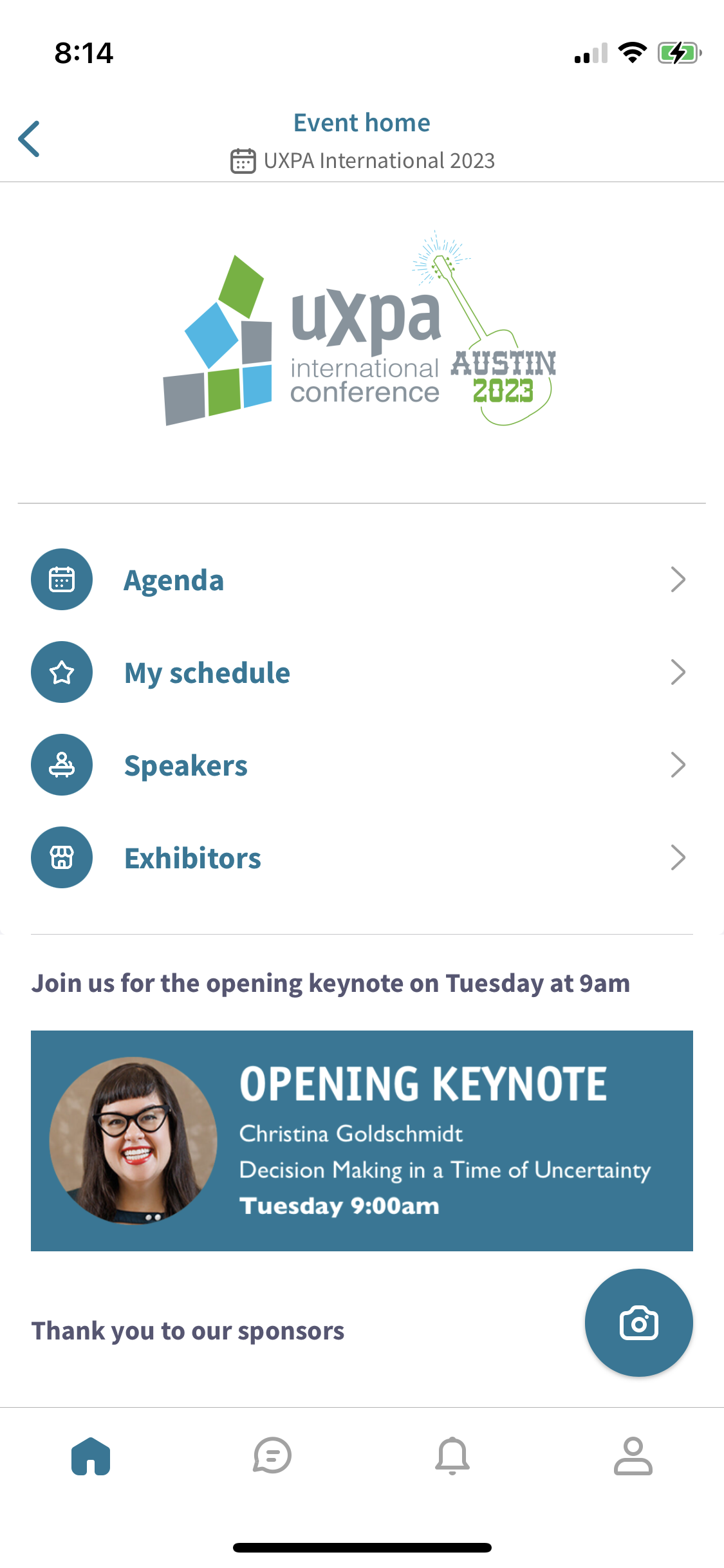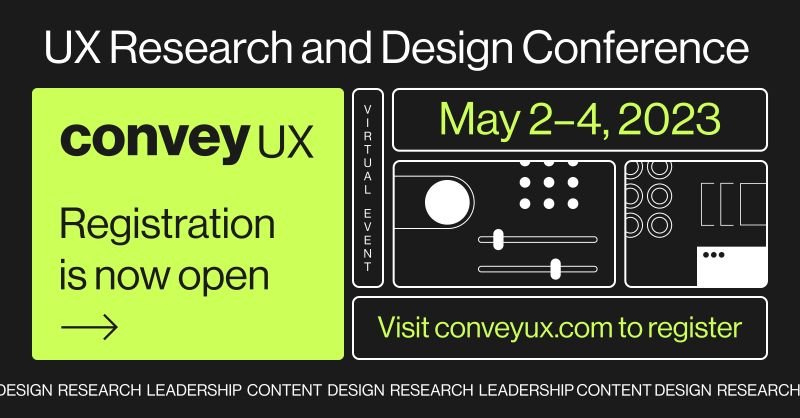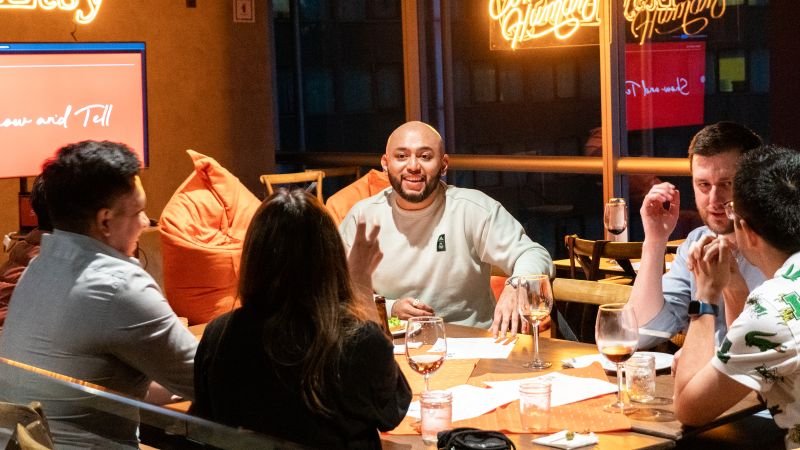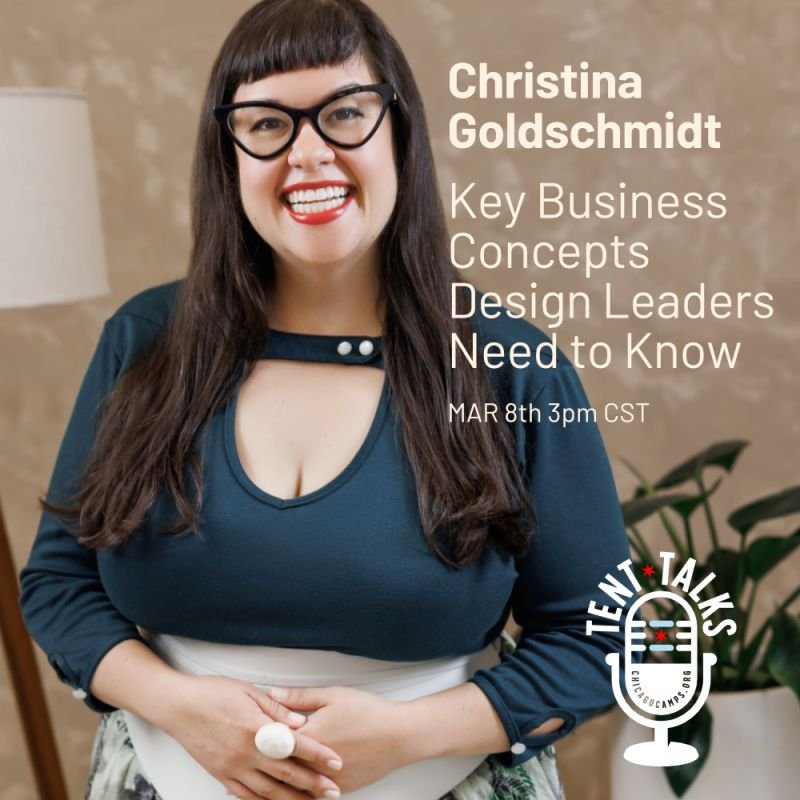Session Transcript:
[00:00:36] Chicago Camps: Christina, tell us about yourself and your design background.
[00:00:40] Christina: I’m the VP and head of product designer at Etsy, so there I lead a decently large team at scale that consists of product designers and managers and directors all working on the marketplace at Etsy. So we work on the buyer experience and the seller experience across all of our platforms.
[00:01:01] Be it mobile, web, desktop, Android, iOS, et cetera, et cetera, across all of our markets. I’ve basically been in digital for over 25 years, which is a hard number to admit, though I’ve been a designer to my core and practicing design for the majority of that, I’ve also had the fortune to jump around throughout my career.
[00:01:24] I got my start as a front end developer in the mid nineties. That sort of is what pulled me in. And then I’ve also done things like been a product manager. I took a stint at that after the downturn of the late, and I’ve been a practicing researcher, a strategist, and so I’ve really had a chance to try on all the hats that make up what it takes to be in the field of digital.
[00:01:47] It’s been really quite an interesting ride from that perspective. And I’ve been in-house, I’ve been at agencies, I’ve been in a variety of different industries, right? So I’m in e-commerce now. I was in in that before. And I’ve also done things like financial services, insurance, InsureTech. I’ve been a management consultant.
[00:02:06] I’ve been in ad tech, I’ve been in media. I’ve worked at a television network. I’ve done hospitality, I’ve even done a little bit of healthcare, and I’ve even been in legal services. It’s really been an education really a lot. And then I think one other thing that I’d love to share is that I’m also really an advocate for mental health and destigmatizing mental health in the workplace.
[00:02:27] And really proud that I’m the executive sponsor of our mental health ERG, and was a co-founder of it at Etsy, I’m sure that’s a topic that we could talk about another day.
[00:02:37] Chicago Camps: Should designers get an MBA, and not to let you off the hook here, why or why not?
[00:02:44] Christina: Alright, so in full disclosure, I have my MBA, I got it in ’08 and I am a graduate of NYU Stern, and I really benefited from it.
[00:02:58] But my advice is that I do not think that most designers need it. And I think that could be controversial for some. I think especially when people will ask me that and they’re like, “Hey, you just said that you really benefited from it. Why are you saying that I don’t need one?” And the reason I would say that is because I think when most people are trying to make this decision, it’s because they’re oftentimes coming to it when they’re a little bit more advanced in their careers.
[00:03:27] It’s really quite the investment, right? It takes a lot of time, and let’s be clear, it is not cheap to get an MBA. So it’s that time and money investment. And also , in all reality, an MBA is pretty much of a generalist kind of degree that isn’t focused on the real things that designers need to advance in their careers and to do everything that they need to do in their jobs.
[00:03:57] And so it’s a huge investment to make That may not necessarily be the thing that somebody needs. Plus, I think there are things that one can do instead that provide that same education. Instead, you could get coaching from a really solid business leader in mentorship and really work with someone that you admire and trust.
[00:04:18] You could do one of the things that I did after my MBA, which is take a rotation as a product manager, and that might be who you start getting that coaching from and then do some of that work yourself. You learn a lot when you’re thrown into the deep end. It’s quite the education that way. Or there are actually tons of classes that you can take.
[00:04:37] Ryan Rumsey has this great program at secondwavedive.com. He even has a, a sub-program there that he calls the Chief Design Officer school. It’s really great. I’ve actually sent several members of my team, not to the Chief Design Officer school, but to some of his other programming online, and they’ve really benefitted from it.
[00:04:56] And then there are other sort of easier, simpler things that you can do. So there’s something called the d.MBA. It’s like d dot MBA is the URL and they offer tons of free resources. They do offer like a paid school option as well, but they offer great podcasts that just demystifies a lot of business concepts and, then they’re also sort of paid MBA sort of type classes that you can take from ed techs online. So things like Section 4 or a company called Alt MBA, and I’m sure there are plenty of others out there, but you can get the same kind of information faster, quicker, cheaper, and you can then pick and choose.
[00:05:37] Chicago Camps: So what do you think the allure is of an MBA?
[00:05:39] Christina: I think people think it’s really going to be this silver bullet. It’s going to give someone instant cred. It’s going to be how you get that immediate seat at the table. Everyone’s going to see you as this accredited business leader, and that magically you’ll be able to easily get buy-in for all of your ideas.
[00:06:02] That’s probably what people think the b a is. It’s that entry card into all those things happening for you. The reality is it just won’t give you those things. I think that you learn foundational items, basics of business concepts, and it’s a thing that can propel your career, but it’s foundational.
[00:06:24] It sets you up for success. It is definitely not instant, and really for me, why it was beneficial was it did things like give me confidence. , it actually reinforced things that I learned on the job that I was afraid to show up with and I was working at the time for a really amazing chief marketing officer, and I worked for her for six and a half years, and I learned so much from her.
[00:06:52] But being a designer, I didn’t have the confidence to say, oh, I know these things. I learned these from this one person, and I can walk into a place and just start sharing that and building off. because you’re like, oh, was she right? Am I applying it right? And so going back and getting my MBA after having that great on the job experience, actually let me say, oh, I now know the exact frameworks that I learned on the job, and now I can recall them like that and I can apply them.
[00:07:26] And then I can learn a bunch of other foundational skills to maybe round out a couple of things that I didn’t know. And now that gives me that sort of confidence to take on much more deeply analytical roles that other designers would shy away from. Or maybe it was, oh, I was predisposed to take those kind of roles in the first place, but now I’d have the confidence to sell myself into them. Whereas before I would’ve been afraid to that kind of type thing.
[00:07:54] Chicago Camps: What are some of the biggest things designers tend to not know enough about as they climb the career ladder?
[00:08:00] Christina: I think that there are some things that people end up missing, and a couple of those are things like they’re afraid of some of the basic math, Excel, budgets, what a profit and loss statement is, or a P&L, and they’re afraid to dive into those things.
[00:08:20] And when you become a design leader, your number one tool actually becomes Excel. You don’t touch Figma, you use Excel, and you have to do things like set the compensation for your entire team and make sure that it’s balanced, even, fair, and that you’re understanding what the implications of it are for multiple years to come.
[00:08:44] So you have to project it into the future. And then also I do things like I manage a rather large OpEx and T & E budget, and so I have to be able to make a case for what that budget needs to be year over year, and also know that I am going to actually hit that budget, not go over it. Also be responsible with it.
[00:09:06] Sure I have a finance partner, but the reality is that it’s on me. It’s my responsibility and I have to help my team manage it. So all of that basic math stuff is really important when you become a leader because your team is also looking to you for those things.
[00:09:22] Another area I would say is the vocabulary. So it’s really your job as a design leader to translate all of the business terms, and let’s be honest, the acronyms that come up in business terms to your team. At Etsy, we’re a publicly traded company, and we have earnings calls. I think it’s really important for my team to understand what goes on at those earnings calls because they do affect us in our business and how we show up for our customers.
[00:09:55] I had to help them understand what’s going on there because it affects a larger business strategy that they then contribute to. Helping them translate that, helping them understand what’s going on in our industry, helping them understand what’s happening with competitors. Helping them understand at a moment of uncertainty, like why are people laying off?
[00:10:15] What do I need to know about that? Helping them understand those terms, what’s happening. That’s really when the vocabulary comes into play.
[00:10:23] Another area that’s really important is contracts. With all those budgets, I actually have to manage and negotiate the contracts. Sure, I have a legal team and a procurement team that helps me with all of that, but we have software, we have talent, we actually have professional development. All of those things that we are doing to grow, support, develop our team comes with a contract. And some of them are very nuanced to our industry that you need to know about so that you can help work with your teams that are supporting you through those contracts to make sure that it works.
[00:11:03] And it’s really important to know that when you’re doing a “true up” for your license, that you have to be able to say, I want you to be able to notify me so that I can kick people off as opposed to preemptively charging me so I can save all of that budget money. Like things like that become very nuanced issues in that contract. That may not be how other software contracts work for other departments.
[00:11:30] And there are other things like important stakeholder management. This was one of those silver bullet topics that we were talking about before. You have to smooth things over. You have to sell in ideas. It’s really important to help make sure that designers help translate how they work to everyone around them, because we have special techniques and tools that really help us be effective, and it’s not about making sure that everyone bends to how we work and that we’re helping everyone know how we work and how we add value.
[00:12:07] It’s my job to make sure that all of my peers up and down understand that value so that I can smooth that over. And then that’s how you get the appropriate headcount and that you can support your team so that they’re not overworked and that you can also sell in ideas and make sure that when your team wants to drive something innovative, or fight for the customer, that it’s always in the right vein that’s going to the right thing for the business. I think that also goes to that balance aspect, right? You really become this business leader, not just a design leader. That balance is really important that you have to understand how you make money, how to balance those decisions, and that you never die on your sword or on that hill when you’re just going to fight only for the user, only for the usability, but how to make those balanced decisions and then explain to your team in a way that they understand it too. So in a sense, the stakeholder management goes both ways.
[00:13:08] I think that’s really important. And then I would say the last thing, which I touched on with the vocabulary is really just different business models and different business concepts. You’re gonna be asked how might we improve our business right now? Or what do you think about pursuing this different strategy?
[00:13:29] And that could be when you’re looking to be innovative, or when you’re looking to face a difficult time, or when someone brings just a new idea to you. How do you evaluate that? How do you think about that in the larger world or in the larger context of your business? And if you don’t understand the basics of business and different business models, you’re gonna get lost.
[00:13:54] You’re really not gonna be able to contextualize it and explain it, and then also help break it down for your team as to why something is or is not a good idea.
[00:14:04] Chicago Camps: As you get to executive leadership levels, how much of what you learned as a designer do you think will be applied to the job?
[00:14:12] Christina: I really love this question, Russ, because the surprise thing is the majority of what really helps and supports me as an executive leader is design skills and things that made me successful as a designer.
[00:14:30] And that is actually the secret.
[00:14:32] Once you master that list of skills that we just talked about with the last question, you can add those in to these amazing skills that we have as designers, and that’s what’s gonna make someone a super powerful executive leader. That’s really the special sauce. I’m gonna give you another long sort of bullet list because I think people are gonna actually feel really good about themselves because it’s going to be very comforting and sort of things that people know.
[00:15:07] One is you have to be naturally curious and willing to ask questions. That is one of your number one jobs as an executive leader is to really just help a team keep thinking, to keep exploring, to look at other angles, and to look from a different lens to see if there’s something else that we should be evaluating and to make sure that it’s actually the right thing and the right approach.
[00:15:39] Another thing is, being able to learn complex things quickly. As designers, we oftentimes are designing things that are not for us. That classic phrase of you are not your user is constant. We have these greats skills of having to learn deep, complex things that have nothing to do with us. So that we can design amazing experiences for people that are not us.
[00:16:12] That skill is really important as an executive leader because you’re gonna have to learn all kinds of different aspects of the business, and that might mean that you have to learn about aspects of the engineering team, or you’re gonna have to learn about aspects of operations, or again, deep aspects of the business model. Being able to have that great skill to learn is really wonderful.
[00:16:42] Another one is actually being detailed oriented. I think people have this idea that when you become an executive leader, that you have a bunch of people running around who take care of all the details for you. The things that we just talked about are actually details that matter.
[00:16:58] If you think about that, when you can keep some details in your head and you can ask questions about some details, you are actually going to help your business and help move your business forward. Now, you are clearly not going to be someone who is going to get into every single detail about every single thing, because that would be impossible, but being able to choose which details matter, and knowing that you have this ability to actually get into details and not be afraid of it when it’s needed is actually really important.
[00:17:40] Another one is being a systems thinker. This is what a designer is. We think in systems, right? I’m constantly thinking in systems, and that is what a business is. A business is a system.
[00:17:52] It’s a whole bunch of interconnected parts. As a systems thinker, you can be a really creative problem solver. You can do things like think three steps ahead because you see how the system works or you can help create the career ladder because it’s a system. You can see how someone will progress in their career.
[00:18:18] Or move from being an IC to a manager or potentially back again because it’s a system. And then you can see how that same document will be used for annual review or a promotion, things like that. You see the whole system.
[00:18:35] Let’s not forget being empathetic. As an executive leader, you are first and foremost a leader, a manager, and so being apathetic is a superpower because you’re really leading and managing an entire team who looks to you for what they need every day. You have to inspire them. You set the tone for how all of the other leaders and managers show up on your team and you advocate for your entire team. Your ability to show up empathetically means that you’re going to be able to help and support them, advocate for them, and put yourself in their shoes so that you can think about all the things that everybody needs. It will allow you to show up vulnerably, which is really hard, but then we’ll let them actually trust you more.
[00:19:30] Another thing is listening. A lot of people forget that as a leader, you have to listen. I tackle every single problem that comes in my door as a design problem. I need to do research. I need to listen. I need to test and prototype it, right? And I need to rinse and repeat. And so listening is really key, not making solutions for my team, for me. I make solutions that work for them because I talk to them, I understand what their jobs are like and what challenges they’re facing. That’s the only way we can operationalize anything to make it better.
[00:20:07] Another one is storytelling. We talked about being able to really sell in ideas and having to do that at all levels. The way that we do that is with storytelling. If you can tell a good story, you can really get someone on board, and that’s what stakeholder management is at its core. Is being able to understand where someone’s coming from. I then tell them stories that help them understand problem solving. I am given constraints, and as a designer, the constraints make my work better, and so I problem solve and I leverage the constraints of maybe there’s a time issue, there’s a budget issue, there’s a headcount issue. Who knows what that issue is. But I can problem solve around it because as a designer, I know how to work with constraints.
[00:20:58] The last one, really: prioritization. We’re always prioritizing when we design as to what’s the most important thing. What’s the most important thing for this persona or to solve this pain point first, or that we can actually get out the door to make a difference faster, or that’s the most feasible, or how I can manage my time and prioritization because you have a million things coming at you and a ton of people to support and a ton of peers.
[00:21:32] You have to be able to prioritize your time to choose what’s the most important thing to do that day, that week, that month, and to know what to go deep on what not to. So prioritization really is the thing that helps you navigate it all.
[00:21:47] Chicago Camps: As an executive design leader, do you have a design portfolio, and if so, what’s in it?
[00:21:54] Christina: Yes. I actually get this question a lot from people who are trying to up-level their careers, and the answer is yes, I do have a portfolio.
[00:22:06] I actually have a website that I keep online and it has gated projects from the past, and they are case studies. They are case studies of teams that I have led.
[00:22:21] It really goes to show how I think about leading work, leading teams, and solving problems, and how I am actually someone who thinks about the three problems of solving for viability, desirability, and feasibility. So I’m thinking about user’s needs, what we can actually make and what’s gonna drive business value.
[00:22:47] I think when I have case studies like that, people see that I can think about how we approach problems as a integrated technology team. The other thing that I also show is my thought leadership because I think it’s really important as an executive leader to gain the followership of your team and one of the most competitive advantages is actually still recruiting.
[00:23:20] Even though it is a volatile market out there, right this moment, people still have choices where they can work. If you can help people see that working at your organization and working for a leader like you is something that they would like to do, and that you are someone who actually promotes someone’s career and promotes that you think that something like thought leadership is going to help them grow their career, too, that’s actually a really nice reciprocal relationship to demonstrate.
[00:23:56] I think it’s really important for people to just share their stories. People wanna know what other people are doing and how other people are working because there’s something to learn from everyone. It really will , especially in our sort of new hybrid world, you’re gonna create community and people are gonna really appreciate it for what you share.




































































